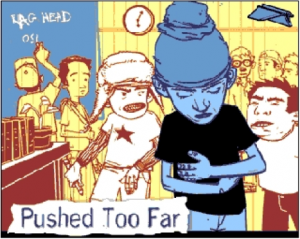Michigan-based Gulshan Singh, 18, felt strongly about countering the widespread bullying of Sikh teenagers in the U.S. “I wanted to do something about it but never knew how to, or never had the means to do it,” said Mr. Singh. In the end, he chose to rhyme about it – and to make a three-minute music video to go with it.
The video, titled “Let It Out,” sums up the emotions of a Sikh teenager who is harassed because he looks different. Mr. Singh said the video, which was recently showcased at the Sikh International Film Festival in New York, is not based on a specific person but on an experience shared by many Sikhs, including many of his friends. Turbans and beards, religious requirements, makes Sikhs stand out in the U.S., where they are a small minority.
This makes Sikh teenagers easy targets for bullies. “Every other Sikh American has been bullied,” said Mr. Singh, adding that it is a “huge problem in America.” He recalls when he was in middle school there was someone constantly pulling his turban. “I tried to stop him but got punched in the nose,” he said.

Mr. Singh felt that there was little awareness about how to deal with it. He felt that a music video was the best way to connect to the youth. “We thought it would be fun and people will pay attention to it,” he said. In the video, the amateur rapper plays a young Sikh who is harassed by a crowd of hooded boys. “Cut your hair, shave your beard, hey why don’t you look the same,” Mr. Singh sings.
Experts agree that the bullying of Asian Americans, and South Asians in particular, is a major problem in the U.S. and say that 9/11 contributed to an increase in the phenomenon in recent years. “There is a connection between the rise in hate crimes after 9/11 against Asian Americans, such as those mistaken for Arabs and Muslims, and racist bullying,” said Eliza Noh, associate professor of Asian American Studies at California State University, Fullerton. “Sikh Indians are often mistaken for Arabs,” she said. Asian Americans were the ones who were bullied most in the U.S., according to a 2009 survey by the U.S. Justice and education department, cited in a recent news report.
There are other reasons why Asian-Americans might be more vulnerable. “They are sometimes seen by their classmates as being ‘nerds’ for doing well in school or for being ‘teacher’s pets,’” said Adrienne Nishina, assistant professor of human and community development at the University of California, Davis. Asian American students are also more likely at having a harder time dealing with bullying, experts say. “They are not brought up to be psychologically expressive in their culture or they may be afraid of revenge from bullies or they may not know to whom to speak about their problems,” said Jin Shin, associate professor of psychology at New York’s Hofstra University in an email interview.
But there are a lot of ways to prevent bullying. “When adults don’t intervene they end up reinforcing bullying,” said Jaana Juvonen, professor of developmental psychology at University of California, Los Angeles. She said that teachers often mistakenly think that older children can deal with such incidences on their own. Students should also make sure to report bullies to authorities, they say.
One way in which Mr. Singh dealt with the boy who kept pulling his turban was by explaining to him the reason behind it. “I told him that we keep hair because we believe it’s God’s gift to us.” That helped. “Once people understand that, they don’t harass you,” he said.
News Source: Wall Street








